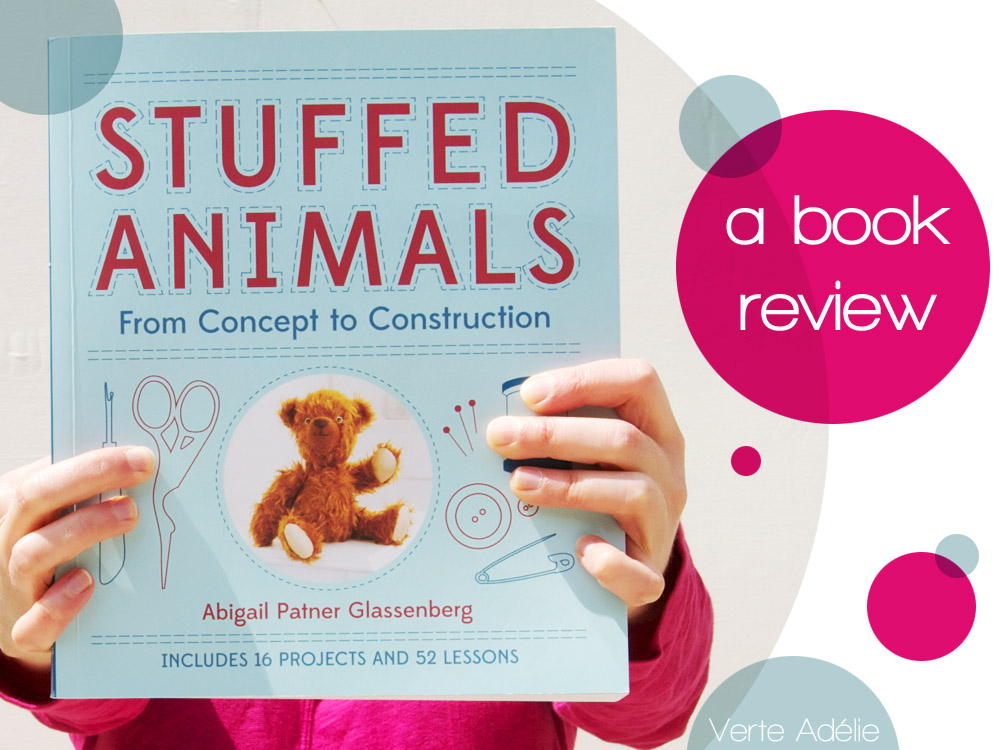
Writing the book you cannot find: isn’t it one of the best reasons to become an author? This is exactly what Abby Glassenberg did with Stuffed Animals, From Concept to Construction. Many years ago, when she got interested in the technicality of sewing stuffed animals, the main source of relevant informations on the subject was a handful of hard to find vintage books. In 2011, armed with the knowledge learnt from her predecessors and years of her own experiences, she wrote a very interesting series of blog posts on the elements of soft toys design. This lead to a contract with an editor, and the possibility to finally write herself the very book she wished she had found when she started. Because I really enjoyed her series of technical posts, I was interested in that project from the start, and I even volunteered when she announced she was looking for pattern testers.
I had never published a book review on my blog until today, which probably explains why a lot of general considerations crept into my draft, that became so tentacular I ended up splitting it into two posts: the one you’re currently reading is a general review in which I digress and ramble about craft books, their usefulness and their usability. The second talks about the book through my experience as a tester, the animals I made, and what I learnt from it (you can now read it here).
Disclaimer: I did receive a free copy of the book, but no one asked me to write a review, and even less to take my review as an opportunity to discuss craft books in general, so needless to say all the opinions tackled hereafter are very obviously my own. Now, let’s talk about the book, shall we?
A little for everybody: technique-filled book and project-based book
When I finally got the book in my hands, my first impression was that it was nicely designed, heavier than expected (almost 200 pages), and packed-full of informations. Actually, I think my exact reaction when I opened it was “wow, well done, Abby!”. And the second was to think that all kinds of people could be interested in that book.
People interested in learning techniques to design and make their own stuffed animals (to give or to sell). This is what makes this book so interesting: its explicit goal is to teach methods to design stuffed animals, not only to recreate existing ones. It doesn’t mean that the patterns provided won’t be interesting, on the contrary: why reinvent the wheel when you can tweak existing pattern pieces to your liking? Each of the 16 animals in the book illustrate lessons. Some of the most efficient ones show what a design would look like with or without a feature, like the picture below, that shows the importance of setting legs on darts! The only lesson I found frustrating (there are 52 lessons in the book) was the one about needle sculpting (lesson 49), as it is very short, and it is a subject I’ve been particularly curious about (I suppose I should try and make the hippo if I want to get a better understanding of how it works). Among my favorite lessons:– the one with pictures showing various placements for the ears of a teddy bear (lesson 42), and how it changes the result dramatically (something useful if you draw too).
– the tips to test the placement of the eyes (one of them being to simply use a round headed pin).
Abby directly suggests in the introduction that people’s creations are good to give… or to sell, as finished objects, or as patterns. So she basically gives away some of the keys to create the same kind of business she created for herself! She also shares plenty of informations on the business part on her blog.
People who have kids, and people who don’t. I was curious to see what title would be chosen for the book, and I think stuffed animals was a smart choice, a good compromise between other options like “soft toys” or “softies” (too child-oriented?) or “soft sculpture” (too scary because of the word sculpture?). In the introduction of her previous book, The Artful Bird, Abby clearly stated that her birds were not toys but rather decorative creations, for display only. In Stuffed Animals, the design and cuddly materials used for all of the animals are clearly of the kind that would particularly appeal to children (Abby has three children and know what they like!). But, if what you want is a purely decorative animal, it is very easy to tweak their appearance without even modifying the pattern itself (as you will see with my kangaroo in the next post – fabric choice and facial features are key). People who just wish to follow a pattern and detailed step by step instructions (and those who dread patterns that say “enlarge by x%”). If you have no wish to create your own design, you don’t have to. All the projects of the book come with detailed step by step instructions with plenty of pictures.
Good things to know about the patterns:
– except for one (the dinosaur), they are all available in the book in their full size (patterns to enlarge are one of Abby’s pet peeves).
– they are also available for download as a free pdf on the editor’s website (Lark Crafts).
My favorite lessons in that category are the ones that show variations of the flat pattern shapes of elements like beaks (lesson 21) or muzzles (lesson 45) side by side with the finished version in volume, and the one that shows all kinds of methods to create spheres (lesson 4). Next time I work on a project that involve volume and fabric, I’ll probably consult this book just like I consult Colette Wolff, The Art of Manipulating Fabric, or the japanese Pattern Magic book mentioned below.
About those things I wish I found more often in craft books
I’d like to mention a few other things, but this is where I start rambling about craft books in a more general manner (I don’t mean to point my finger at Abby’s book as if it was the only one). Plus, those things more likely fall within the competence of the editor rather than the author’s. That said, I wish the book had the three following features: a visual index of the projects, a detailed index of the content, and a bibliography.
A visual index of the projects. I really like that the table of content is entirely visible on a double page. I just wish there was a quick way to get an overview of all the animals available in the book without having to leaf through the whole of it, either on a separate page of thumbnails, or directly within the table of contents. Here’s an example of a table of contents I find especially useful and usable as a reader, in the english version of the japanese book Pattern magic, by Tomoko Nakamichi. I love the amount of informations you get all at once on this page.A detailed index of the content. I wonder how the book would have worked if organized in a more encyclopedic way (imagine a chapter regrouping everything about facial features, another entirely dedicated to stuffing, etc.). This is not the option that was chosen, which is perfectly ok, but I wish there was a real detailed index (or something like an analytical table of contents?) to compensate the fact that different elements on a specific subject are spread throughout the book. “But there is an index”, you may object if you own the book. Yes, there is, but it’s merely an alphabetic list of the lessons and boxed texts titles. If you have a look at the letter M, you’ll find several entries starting with “making”. “Making your own set of eyes” would be more useful under Eye, not Making, “Simple strip gusset” under Gusset, not Simple, etc.
A bibliography. In the introduction (and even more prominently on her blog, that is only mentioned in the “About the author” paragraph at the very end of the book), Abby makes it clear that her present knowledge is the result of both a lot of experimentation and the study of old books I mentioned in the introduction of this post. It would have been great to have a curated list of those references (even if most of them are hard to find today), perhaps even a commented one, both because it would allow the most curious readers to explore the subject further, and also simply because it’s always important to acknowledge we’re all standing on the shoulders of giants, at least in a technical reference book like this one. Or what about the option of a link to an easy to find landing page on Abby’s site?
On the (increased?) importance of paper books usability in the age of online resources
After writing those last three points, I was almost about to apologize for my nerdiness and the obvious influence of my education (in History and Archival Sciences), former career (I was an archivist for 10 years), and general disposition (insert extreme organization geekiness here). But please bear with me while I explain why I stand firm!
As much as I am an avid user of all kinds of online resources and ebooks, right now, I still find paper books much more convenient than ebooks for non linear reading. I’ll spare you my wish-list of what ebook navigation should entail, and I’m sure big progresses will be made on that matter in a not too distant future. Meanwhile…
I absolutely love the idea of enriching the content of a book (without the inevitable constraints of the traditional paper edition world) by offering related online resources, created either by the author or by the readers, like in the case of Abby’s book, a gallery of what people have made from it, or a list of all the online reviews available. However, it doesn’t mean a reference book shouldn’t strive to be as self-sufficient as possible when it is published, if only because as far as I know, books still last longer than websites (hear, hear, if this isn’t the former archivist speaking here!).
Have you ever been in the middle of reading a paper book when you suddenly felt the urge to make a full-text search in it, only to remember the second after that, uh, well, no? I know I have, which probably shows that I spend far too much time online. But apparently, our glorious ancestors wanted to be able to search their books too, since they invented smart things like those curated lists of relevant keywords called indexes. So you see, I don’t think I’m foolishly asking from craft books things you would only expect from academic publications. I think now more than ever, when we’re all so used to searching contents easily, books should offer more of those time-tested tools like indexes, not less. And if you object that people don’t want to use indexes, then let’s represent informations in a more graphic way. User interface isn’t only important in human-machine interactions. Let’s be thoughtful and playful! And let’s publish more technical books like Abby’s, and make them as usable as they are useful.
A few more informations:
– What’s publishing ever done for us? interesting blog post (and comments) by Karen of Did You Make That?, who happens to work in publishing.
– A video presentation and several featurettes about Abby’s book on Vimeo.
What do you think of all this? What kind of craft books do you find useful? Do you think they could be more convenient to use?
Lorsqu’Abby Glassenberg a commencé à s’intéresser à la couture d’animaux en tissus, les seuls livres sur le sujet étaient très anciens, et assez difficiles à trouver. En 2011, elle a écrit une intéressante série de posts de blogs sur ces techniques de couture, qui a débouché sur un contrat avec un éditeur, et la possibilité d’écrire elle-même ce livre qu’elle aurait voulu trouver lorsqu’elle a commencé. Il a été publié aux USA il y a quelques semaines, et s’appelle Stuffed Animals, From Concept to Construction. Son projet de livre m’ayant intéressée dès le départ, je me suis portée volontaire lorsqu’elle a lancé un appel pour trouver des testeurs pour les patrons créés pour le livre.
Je n’avais jamais écrit de critique de livre sur mon blog avant aujourd’hui, ce qui explique peut-être pourquoi mon brouillon est rapidement devenu tentaculaire et encombré de toutes sortes de considérations générales sur l’édition. J’ai fini par en faire 2 articles séparés : celui que vous êtes en train de lire est une critique générale, qui digresse rapidement sur l’utilité des craft books et leur ergonomie (désolée si j’utilise l’expression craft book telle quelle, mais je n’ai jamais aimé l’expression loisirs créatifs, et je ne vois pas trop comment la traduire autrement !). Le second (à venir) parle du livre à travers mon expérience de testeuse, des animaux que j’ai cousus à cette occasion, et de ce que j’en ai retenu.
J’ai reçu un exemplaire gratuit de ce livre, mais personne ne m’a demandé d’en écrire une critique, et encore moins de profiter de cette critique pour discuter des craft books en général, donc inutile de dire que le point de vue exprimé ici est purement le mien !
Un peu de tout pour tout le monde : un livre technique, et un livre de projets
Le livre est beau et plein à craquer d’informations extrêmement utiles, et peut probablement intéresser toutes sortes de publics.
– les gens intéressés par l’apprentissage des techniques nécessaires pour créer leurs propres designs d’animaux : le livre contient 52 leçons dont c’est exactement le but.
– les gens qui ont des enfants, et ceux qui n’en ont pas : la plupart des animaux du livre semblent avoir été créés pour devenir des jouets, mais il suffit de pas grand chose pour les transformer en objets plus décoratifs.
– les gens qui veulent simplement suivre un patron pour récrer les projets du livre : les instructions sont détaillées, avec beaucoup de photos, étape par étape. Bon à savoir : les patrons sont disponibles en taille réelle dans le livre (une seule exception), et sont également disponibles en pdf sur le site de l’éditeur.
– les gens qui s’intéressent de façon générale à la manipulation du tissu pour créer du volume.
À propos de ces choses que j’aimerais trouver plus souvent dans les livres
– un index visuel : dans le livre d’Abby, j’aimerais pouvoir en un coup d’oeil avoir un aperçu de tous les animaux disponibles dans le livre, sans avoir à le feuilleter en entier.
– un index détaillé : l’index tel qu’il est présenté dans le livre n’est pas vraiment pratique, parce qu’il est basé sur les titres de chapitres et non sur des mots clés signifiants.
– une bibliographie : Abby ne cache pas sur son blog qu’elle doit beaucoup aux auteurs des vieux livres qu’elle a utilisés à ses débuts. J’aurais aimé en trouver une liste dans son livre.
De l’importance de l’ergonomie des livres papier à l’époque des ressources en ligne
Pour tout ce qui n’est pas du domaine de la fiction, je continue à trouver les livres papier plus faciles à manipuler que les livres électroniques. Internet nous a tellement habitués aux recherches plein texte et aux liens vers des informations complémentaires qu’il m’arrive de lire un livre papier et de soudainement avoir le réflexe de faire une recherche plein texte à l’intérieur (ce qui montre probablement que je passe trop de temps en ligne). Nos ancêtres aimaient manifestement aussi avoir la possibilité de chercher dans leurs livres, puisqu’ils ont inventé des outils comme… les index ! Ces outils me semblent donc toujours utiles aujourd’hui, peut-être plus que jamais, de même que toute autre façon de représenter l’information pour la rendre aussi accessible que possible.











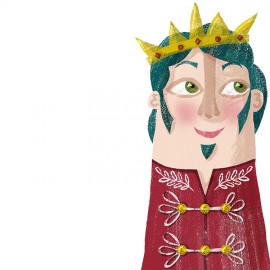
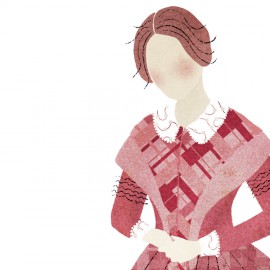
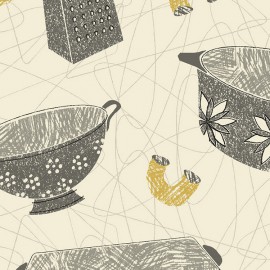
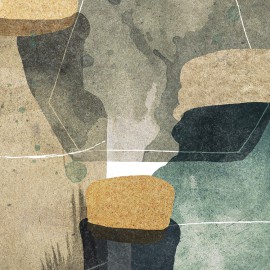
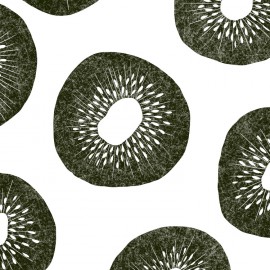
Abby Glassenberg
Jun 24, 2013 -
Thank you so much for this interesting and detailed review of my book. I love all of your points and I truly appreciate how well you read each part and understood my goals with this project. This book was originally planned to be quite a bit shorter, but I found the topic to be so large and so fascinating that I couldn’t bear to part with my longer manuscript. Instead of 164 pages it became 190 and, as a result, it lost the opportunity to have a more comprehensive index. My dear editor, Thom O’Hearn, loves a good index. He did the absolute best we could with the space we had. I agree with you that paper books are still better than digital, but they are expensive and every single page adds more to the cost of the final product. Anyway, thank you. You were an amazing pattern tester and I’m truly grateful! I’ll look forward to part II.
-Abby
Verte Adélie
Jun 26, 2013 -
Thank you Abby, it’s great to have your perspective on the index thing. I hope you don’t mind that I highjacked your book review to make it a more general reflexion, but I took the liberty of doing it because that’s what you sometimes do in your own book reviews too. :)
Verte Adelie | Stuffed animals, by Abby Glassenberg (part 2): a few things I learnt while being a pattern tester for the book
Jul 1, 2013 -
[…] I mentioned in my previous post about Abby Glassenberg’s book Stuffed Animals, From Concept to Construction, I tested several […]
Louise Hilton
Jul 31, 2014 -
Hi,
I am a beginner sewer, I have just purchased a sewing machine and I am currently in the process of learning how to use it effectivley before tackling an actual item of any type.
have a question to ask with regards to your prototypes.
Your cat bag is a great example of making a prototype before making the finished item, but what material do you make your prototypes out of and do with them once you have finished them?
Your post was very informative, and I will be dropping very loud hints to my boyfriend with regards to as what I would like for Christmas this year.
Thanks
Louise
Ewan
Apr 2, 2020 -
Somee truly nice and utilitarian info on this site, besides I think the
design haas fantastic features.
seo Buckinghamshire
Apr 16, 2020 -
Keep up the great work, I rread few ontent on this web site and I believe that your website is really intsresting and has got bands
of fantastic information.
Janie
Jul 4, 2020 -
hello!,I love you writing so a lot! share wwe communicate more approximately your article on AOL?
I need an expert on this area to solve my problem. May be that is you!
Looking ahead to look you.
my website easy hula dance routine, Janie,
IMT interview questions
Sep 29, 2020 -
It’s amazing in support of me to have a site, which is valuable in favor of my experience.
thanks admin
Feeel frwe to visit my homepage … IMT interview questions
flower shop London England
Oct 12, 2020 -
I hhave been reading out many of your stories
and i cann state niuce stuff. I will surely bookmark youur blog.
Herre is mmy web-site … flower shop London England
best biodegradable cups
Nov 12, 2020 -
This is a really good tipp especially to those fresh to the blogosphere.
Short but very precise information… Many thanks for sharing this one.
A must read post!
My blog post best biodegradable cups
сайт
Jun 21, 2021 -
Such a pretty look
http://5834.adminka.cc
Spironolactone pr
Oct 18, 2022 -
donepezil pharmacy donepezil 5 mg purchasedonepezil tablet donepezil purchase
Depakote pr
Oct 23, 2022 -
imuran cost imuran pills imuran australia
Azathioprine pr
Oct 24, 2022 -
avapro tablets avapro online where to buy avapro
Olmesartan pr
Oct 30, 2022 -
risperdal pills risperdal without a prescription risperdal united states
Diltiazem pr
Nov 1, 2022 -
desmopressin price how to buy desmopressin 10 mcgdesmopressin price desmopressin purchase
Escitalopram pr
Nov 3, 2022 -
glimepiride purchase glimepiride 1mg australiaglimepiride tablet order glimepiride
Flomax pr
Nov 5, 2022 -
dutasteride no prescription dutasteride 0,5 mg pharmacydutasteride price dutasteride coupon
Ciprofloxacin pr
Nov 6, 2022 -
crestor 10mg for sale how to purchase crestor 20mg crestor 10 mg online pharmacy
Lelandillera
Jan 28, 2023 -
жЉњгЃ‘жЇ›гЃ®дє€йІжі•
remeron cheap
Feb 18, 2023 -
symbicort inhaler without a doctor prescription symbicort inhaler 160/4,5mcg generic symbicort inhaler prices